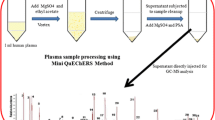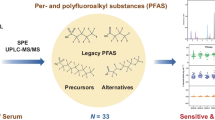Abstract
Analysis of biofluids, such as plasma, can be used to investigate occupational pesticide exposure in the agricultural industry. Considering the chemical complexity and variability of plasma samples, any protocol for pesticide analysis should achieve efficient sample cleanup to minimize matrix effects and enhance method sensitivity through analyte pre-concentration. In this work, a high-throughput method was developed for analysis of 79 pesticides, commonly used in agricultural practices, in human plasma, using biocompatible solid-phase microextraction (SPME) coupled to liquid chromatography–tandem mass spectrometry. An SPME method was developed using a biocompatible hydrophilic–lipophilic balance/polyacrylonitrile (HLB/PAN) extraction phase and demonstrated negligible matrix effects. The performance of the developed SPME method was compared to a QuEChERS —Quick, Easy, Cheap, Effective, Rugged, and Safe— method, the most common sample preparation and cleanup approach for pesticide analysis in complex matrices. Comparable accuracy and precision were achieved for both methods, with accuracy values within 70–120% and relative standard deviation < 15%. Overall, the developed SPME and QuEChERS methods extracted 79 out of 82 monitored pesticides in human plasma. The SPME protocol demonstrated higher sensitivity than the QuEChERS method and a drastic reduction of matrix effects.
Graphical Abstract





Similar content being viewed by others
References
Damalas CA, Eleftherohorinos IG. Pesticide exposure, safety issues, and risk assessment indicators. Int J Environ Res Public Health. 2011;8:1402–19. https://doi.org/10.3390/ijerph8051402.
Alavanja MCR. Pesticides use and exposure extensive worldwide. Rev Environ Health. 2009;24:303–9. https://doi.org/10.1515/REVEH.2009.24.4.303.
Philippe V, Neveen A, Marwa A, Ahmad AYBasel. Occurrence of pesticide residues in fruits and vegetables for the Eastern Mediterranean Region and potential impact on public health. Food Control. 2021;119:107457. https://doi.org/10.1016/j.foodcont.2020.107457.
Curl CL, Beresford SAA, Fenske RA, Fitzpatrick AL, Lu C, Nettleton JA, Kaufman JD. Estimating pesticide exposure from dietary intake and organic food choices: the multi-ethnic study of atherosclerosis (MESA). Environ Health Perspect. 2014;123:475–83. https://doi.org/10.1289/ehp.1408197.
Damalas CA, Koutroubas SD. Farmers’ exposure to pesticides: toxicity types and ways of prevention. Toxics. 2016;4:1–10. https://doi.org/10.3390/toxics4010001.
Dhananjayan V, Ravichandran B. Occupational health risk of farmers exposed to pesticides in agricultural activities. Curr Opin Environ Sci Heal. 2018;4:31–7. https://doi.org/10.1016/j.coesh.2018.07.005.
Fishel FM (2015) A summary of revisions to the worker protection. Edis 1–5.
Hornstein JS, Ellerhoff J (2018) Compliance with the worker protection standard. https://doi.org/10.31274/icm-180809-529.
Corva D, Meisel JS (2021) The Routledge Handbook of Post-Prohibition Cannabis Research.
Pinkhasova DV, Jameson LE, Conrow KD, Simeone MP, Davis AP, Wiegers TC, Mattingly CJ, Leung MCK. Regulatory status of pesticide residues in cannabis: implications to medical use in neurological diseases. Curr Res Toxicol. 2021;2:140–8. https://doi.org/10.1016/j.crtox.2021.02.007.
Zhang J, Stewart R, Phillips M, Shi Q, Prince M. Pesticide exposure and suicidal ideation in rural communities in Zhejiang province, China. Bull World Health Organ. 2009;87:746–53. https://doi.org/10.2471/BLT.08.054122.
Alves A, Kucharska A, Erratico C, Xu F, Den Hond E, Koppen G, Vanermen G, Covaci A, Voorspoels S. Human biomonitoring of emerging pollutants through non-invasive matrices: state of the art and future potential. Anal Bioanal Chem. 2014;406:4063–88. https://doi.org/10.1007/S00216-014-7748-1.
Panuwet P, Jr REH, Souza PED, Chen X, Radford A, Cohen JR, Marder ME, Kartavenka K, Barry P, Barr DB (2016) Biological matrix effects in quantitative tandem mass spectrometry-based analytical methods: advancing biomonitoring. 46:93–105. https://doi.org/10.1080/10408347.2014.980775.Biological.
Godage NH, Gionfriddo E. Biocompatible SPME coupled to GC/MS for analysis of xenobiotics in blood plasma. J Chromatogr B Anal Technol Biomed Life Sci. 2022;1203:123308. https://doi.org/10.1016/j.jchromb.2022.123308.
Lehmann E, Oltramare C, NfonDibié JJ, Konaté Y, d Alencastro LF. Assessment of human exposure to pesticides by hair analysis: the case of vegetable-producing areas in Burkina Faso. Environ Int. 2018;111:317–31. https://doi.org/10.1016/j.envint.2017.10.025.
Baynes RE, Riviere JE (2010) Absorption. Hayes’ Handb Pestic Toxicol 877–892. https://doi.org/10.1016/B978-0-12-374367-1.00037-9.
Hernández F, Sancho JV, Pozo OJ. Critical review of the application of liquid chromatography/mass spectrometry to the determination of pesticide residues in biological samples. Anal Bioanal Chem. 2005;382:934–46. https://doi.org/10.1007/s00216-005-3185-5.
Jiang R, Xu J, Zhu F, Luan T, Zeng F, Shen Y, Ouyang G. Study of complex matrix effect on solid phase microextraction for biological sample analysis. J Chromatogr A. 2015;1411:34–40. https://doi.org/10.1016/j.chroma.2015.07.118.
Cichelli J, Doyle RM (2015) LC/MS/MS analysis of barbiturates in urine, oral fluid and blood. 5000.
Campíns-Falcó P, Sevillano-Cabeza A, Herráez-Hernández R, Molins-Legua C, Moliner-Martínez Y, Verdú-Andrés J. Solid-phase extraction and clean-up procedures in pharmaceutical analysis. Encycl Anal Chem. 2012. https://doi.org/10.1002/9780470027318.a1920.pub2.
Wilkowska A, Biziuk M. Determination of pesticide residues in food matrices using the QuEChERS methodology. Food Chem. 2011;125:803–12. https://doi.org/10.1016/j.foodchem.2010.09.094.
Simpson H, Berthemy A, Buhrman D, Burton R, Newton J, Kealy M, Wells D, Wu D. High throughput liquid chromatography/mass spectrometry bioanalysis using 96-well disk solid phase extraction plate for the sample preparation. Rapid Commun Mass Spectrom. 1998;12:75–82. https://doi.org/10.1002/(SICI)1097-0231(19980131)12:2%3c75::AID-RCM112%3e3.0.CO;2-C.
Godage NH, Gionfriddo E. A critical outlook on recent developments and applications of matrix compatible coatings for solid phase microextraction. TrAC - Trends Anal Chem. 2019;111:220–8. https://doi.org/10.1016/j.trac.2018.12.019.
(2018) Food and Drug Administration, Bioanalytical Method validation guidance.
Dutta S, Basu N, Mandal D. ESIPT in a binary mixture of non-polar and protic polar solvents : role of solvation dynamics. J Photochem Photobiol A Chem. 2022;435:114240. https://doi.org/10.1016/j.jphotochem.2022.114240.
Darvishnejad F, Raoof JB, Ghani M. MIL-101 (Cr) @ graphene oxide-reinforced hollow fiber solid-phase microextraction coupled with high-performance liquid chromatography to determine diazinon and chlorpyrifos in tomato, cucumber and agricultural water. Anal Chim Acta. 2020;1140:99–110. https://doi.org/10.1016/j.aca.2020.10.015.
Morales EL, Sinuco LDC, Ahumada DA (2020) Stabilization strategies for unstable pesticides in calibration reference materials. 17th IMEKO TC 10 EUROLAB Virtual Conf “Global Trends Testing, Diagnostics Insp 2030” 129–134.
Godage NH, Cudjoe E, Neupane R, Boddu SH, Bolla PK, Renukuntla J, Gionfriddo E (2020) Biocompatible SPME fibers for direct monitoring of nicotine and its metabolites at ultra trace concentration in rabbit plasma following the application of smoking cessation formulations. J Chromatogr A 1626:. https://doi.org/10.1016/j.chroma.2020.461333.
Risticevic S, Lord H, Górecki T, Arthur CL, Pawliszyn J. Protocol for solid-phase microextraction method development. Nat Protoc. 2010;5:122–39. https://doi.org/10.1038/nprot.2009.179.
Brandt JM, Brière LK, Marr J, MacDonald SJ, Bourne RB, Medley JB. Biochemical comparisons of osteoarthritic human synovial fluid with calf sera used in knee simulator wear testing. J Biomed Mater Res - Part A. 2010;94:961–71. https://doi.org/10.1002/jbm.a.32728.
Shiea J, Bhat SM, Su H, Kumar V, Lee CW, Wang CH (2020) Rapid quantification of acetaminophen in plasma using solid-phase microextraction coupled with thermal desorption electrospray ionization mass spectrometry. Rapid Commun Mass Spectrom 34: https://doi.org/10.1002/rcm.8564.
Abdel-Rehim M, Bielenstein M, Arvidsson T (2000) Evaluation of solid-phase microextraction in combination with gas chromatography (SPME-GC) as a tool for quantitative bioanalysis. J Microcolumn Sep 12:308–315. https://doi.org/10.1002/(SICI)1520-667X(2000)12:5<308::AID-MCS5>3.0.CO;2-F.
Prosen H, Zupančič-Kralj L. Solid-phase microextraction. TrAC - Trends Anal Chem. 1999;18:272–82. https://doi.org/10.1016/S0165-9936(98)00109-5.
Matuszewski BK, Constanzer ML, Chavez-Eng CM. Matrix effect in quantitative LC/MS/MS analyses of biological fluids: a method for determination of finasteride in human plasma at picogram per milliliter concentrations. Anal Chem. 1998;70:882–9. https://doi.org/10.1021/ac971078+.
Funding
The authors thank the University of Toledo for funding and Supelco, MilliporeSigma, for providing the SPME devices tested in this work. T.C. acknowledges the Office of Undergraduate Research at the University of Toledo for providing funding to conduct this work through the Undergraduate Research Academic Year Research Program.
Author information
Authors and Affiliations
Corresponding author
Ethics declarations
Conflict of interest
The authors declare no competing interests.
Additional information
Publisher's note
Springer Nature remains neutral with regard to jurisdictional claims in published maps and institutional affiliations.
Published in the topical collection Young Investigators in (Bio-)Analytical Chemistry 2023 with guest editors Zhi-Yuan Gu, Beatriz Jurado-Sánchez, Thomas H. Linz, Leandro Wang Hantao, Nongnoot Wongkaew, and Peng Wu.
Supplementary Information
Below is the link to the electronic supplementary material.
Rights and permissions
Springer Nature or its licensor (e.g. a society or other partner) holds exclusive rights to this article under a publishing agreement with the author(s) or other rightsholder(s); author self-archiving of the accepted manuscript version of this article is solely governed by the terms of such publishing agreement and applicable law.
About this article
Cite this article
Godage, N.H., Cudjoe, E., Chau, T. et al. Quantitative determination of pesticides in human plasma using bio-SPME-LC–MS/MS: a robust tool to assess occupational exposure to pesticides. Anal Bioanal Chem 415, 4423–4434 (2023). https://doi.org/10.1007/s00216-023-04589-8
Received:
Revised:
Accepted:
Published:
Issue Date:
DOI: https://doi.org/10.1007/s00216-023-04589-8




